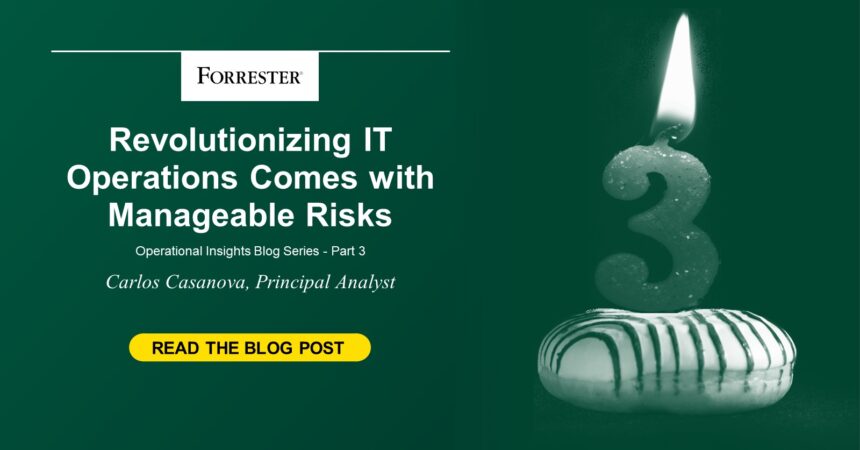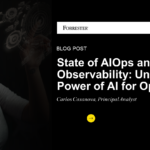This is the last of a three-part IT operational insight blog series that aligns with the complementary research reports from Forrester. Click the links for part one and part two of the free blogs for a complete perspective on operational insights delivered by AIOps and observability.
The drive to optimize and become a high-performance IT organization has driven AIOps and observability to a position of prominence. These technologies offer the promise of improved operational efficiency and enhanced customer experiences. The experiences of external users and customers in addition to employees working with these systems all benefit from the cohesive insights these technologies provide. However, like any transformative initiative, there are risks associated with implementing AIOps and observability. Awareness of these risks is the first step in mitigating the potential impact on your organization. They are not insurmountable but left unattended, they could be disastrous. In Consider Five Risks When Implementing AIOps And Observability For IT Operational Insights, you will learn about the five key risks that need to be mitigated:
- Inadequate Data Quality and Availability
- Lack of Skills and Expertise
- Integration and Compatibility Issues
- Ethical and Privacy Concerns
- Over-Reliance on Automation
Manage and integrate your data properly
You may be getting tired of hearing about data quality being core to success if you have been following this series of operational insights blogs. Well, get ready because I am beating that drum yet again. Implementing AIOps and observability relies heavily on the availability of high-quality data. You must ensure that the data collected is accurate, complete, and relevant to achieve meaningful insights. To mitigate the risk of poor data quality, you must establish data quality management processes, often part of your enabling motion. This includes regular data audits, data cleansing, and implementing mechanisms for data collection that ensure accuracy and reliability. By ensuring the data is of high quality, you can make more informed decisions based on accurate insights.
There is no alternative to privacy, ethics, skills, or expertise.
Leveraging the full potential of AIOps and observability requires skilled professionals who possess both technical knowledge and an understanding of the business context, especially when an IT organization is focused on cocreating. Unfortunately, there is a shortage of experts in the market with these specialized skills. To overcome this challenge, you must invest in upskilling your existing IT teams through training programs. Partner with external consultants or consider a managed service provider who specializes in AIOps and observability to help provide the necessary expertise. A skilled workforce running at the right velocity with the proper momentum can effectively utilize these technologies to optimize your IT operations.
The collection and analysis of vast amounts of data can raise ethical and privacy concerns, particularly with regulations such as GDPR and CCPA. You must ensure that data collection and usage comply with relevant regulations and industry best practices. Implement robust data governance frameworks to safeguard data privacy. Obtain explicit consent from users and anonymize sensitive data help mitigate ethical and privacy risks. Read my report, and complementary blog, on utilizing synthetic data for AIOps for a deep dive into the topic. By prioritizing ethical and privacy considerations, you can build trust with customers and maintain compliance with regulatory requirements.
Technology is awesome but tread carefully
It is no surprise, if you have been following this series, that automation is a core feature of AIOps, but you must exercise caution to avoid over-reliance on automated systems. Blindly trusting automated systems without proper human oversight can lead to incorrect or biased outcomes. Mitigate this risk by establishing clear guidelines for human intervention in the decision-making process. Monitor the performance of automated systems and conduct regular audits to ensure accuracy and reliability. Strike a balance between automation and human expertise, to harness the full potential of AIOps while minimizing the risks associated with over-reliance on automation.
Move forward with your revolution but mitigate your risks first.
Implementing AIOps and observability can revolutionize IT operations and enable organizations to improve operational effectiveness and deliver exceptional customer experiences. However, it is essential to be aware of the risks involved and take proactive measures to mitigate them. By addressing issues related to data quality, skills and expertise, integration, ethics, and automation, businesses can confidently embrace these technologies. With careful planning, diligent execution, and a focus on risk mitigation, AIOps and observability can become powerful allies in the journey towards optimizing IT operations and achieving digital excellence.
Join the Conversation
I invite you to reach out to me through social media if you want to provide general feedback. If you prefer more formal or private discussions, email inquiry@forrester.com to set up a meeting! Click Carlos at Forrester.com to follow my research and continue the discussion.








